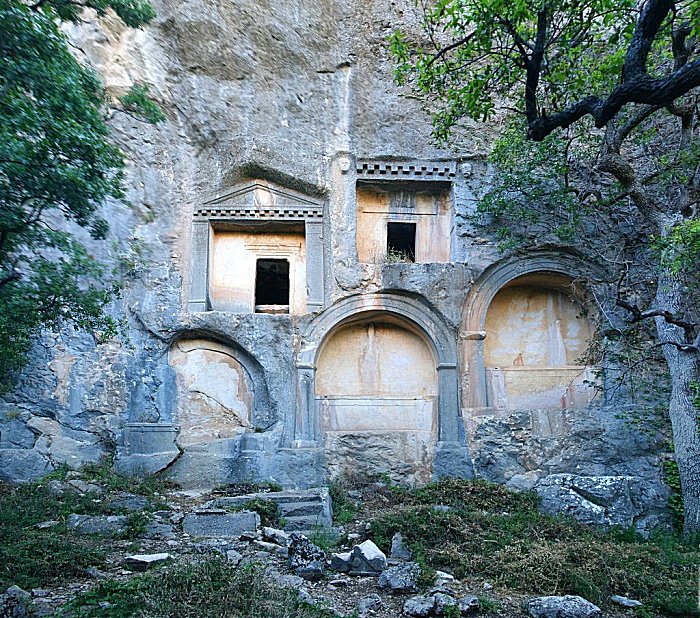Termessos – Where History And Mythology Marked People’s Daily Lives

A. Sutherland – AncientPages.com – Pisidian people built the city of Termessos 1,050 meters above sea level, providing them a great advantage against possible attacking enemies.
Rock-cut tombs along the main road into Termessos. Image credit: Ingo Mehling – CC BY-SA 3.0
“.. Termessos maintained its independence even under the dominion of the Persians and refused to receive Alexander the Great, who dared not besiege it (Arianus, I, 27). Under the successor of Alexander, Termessos preserved its autonomy and, in 189 B. C., formed an alliance with the Roman consul, Cn. Manlius, who confirmed it; under the Emperor Domitian ,it still enjoyed this alliance. Subsequently, the city was incorporated with the Province of Pisidia and later with that of Pamphylia. From the ruins of the monuments that remain, it is evident that this was one of the richest and the most civilized cities of Asia Minor; as far back at least as the fourth century B. C., it had been colonized by the Hellenic race…” 1
Termessos was one of the most ancient Pisidian cities, inhabited by the Solims (Solymi,) a brave tribe of warriors from the Northern Lycia.
Termessos amphitheatre. Image credit: Capyusuf – CC BY-SA 4.0
Their name, preserved for many centuries in Mt. Solyma, was referred to by Strabo and Homer in the Iliad in connection with the legend of Bellerophon, a mythical founder of Termessos.
The early history of the inhabitants of this city is relatively obscure, however, it is known that the city successfully defended itself against Alexander the Great in c. 333 BC.
The city’s strategically perfect location on the southwest side of the mountain Solymos (today: Güllük Dagi) in the Taurus Mountains – helped citizens defend themselves against Alexander the Great in around 333 BC.
A powerful Macedonian king and military genius, he conquered vast territories from Greece to Egypt and India but experienced problems in Termessos.
Hadrian’s Gate. Image credit: Zythème – CC BY-SA 3.0 DEED
Was it mainly due to the challenging terrain, with steep mountain slopes and gorges that served as effective natural defenses for the people of Termessos?
Or was it something else?
Arrian of Nicomedia (c. 86/89 – c. after 146/160 AD), a Greek historian and military commander, wrote that even a small force could easily defend Termessos due to the invincible natural barriers protecting the city. The city’s location at the mountain passes from the Phrygian hinterland to the plains of Pamphylia.
Initially, Alexander wanted to go to Phrygia from Pamphylia, and according to Arrian, the road passed by Termessos. However, there were also other passes, much more comfortable to access.
So, the question is, why did Alexander choose to ascend the troublesome and steep Yenice Pass?
It is even said that his hosts in Perge sent Alexander up the wrong path. Alexander wasted a lot of time trying to force his way through the pass, which had already been closed by the Termessians. Furious, Alexander decided to march north and attack Sagalassos instead.
Probably, he knew he could not seize Termessos and so it happened. The ‘Eagle’s Nest,’ as he called the city of Termessos, did not surrender to his famous military forces.
Alexander failed in this military confrontation, and it turned out to be a much more serious problem than the Gordian Knot, he once experienced.
In the 2nd century BC, Termessos was actively engaged in various disputes. At first, it was a conflict with the alliance of Lycian cities, and later, it found itself at odds with its neighbors from the city of Isinda. In the midst of another dispute, this time involving Selge, Termessos decided to join forces with the king of Pergamon, Attalos II, and thus, a new alliance was successfully established.
Coins of Termessos. Image credit: Define Vadisi – CC BY-SA 4.0
Termessos eventually aligned itself with Rome, ultimately becoming a significant component of the Roman Empire. In the era of Roman dominance over Asia Minor, the city of Termessos stood out as a remarkably independent entity.
Rome acknowledged it as a “friend and ally,” granting it degree of autonomy. The inhabitants were free to establish their own legal frameworks and even mint their own currency.
The good ends sooner or later. The downfall of Termessos’ prosperity and survival was triggered by an earthquake that demolished the city’s aqueduct, cutting off its drinking water supply. The precise timing of this catastrophic event remains undetermined.
By the 5th century AD, the city had already been completely abandoned. From that point onwards, it slipped into obscurity until modern explorers stumbled upon it.
Archaeologists have discovered the remnants of six temples in Termessos so far. Five of these historical structures are near the agora and bouleuterion (a meeting place of the city council). The sixth one, the previously mentioned Temple of Artemis and Hadrian, is strategically positioned at the city’s entrance. There are also ruins of once impressive theater and wonderfully looking Hadrian’s Gate.
Written by – A. Sutherland – AncientPages.com Senior Staff Writer
Copyright © AncientPages.com All rights reserved. This material may not be published, broadcast, rewritten or redistributed in whole or part without the express written permission of AncientPages.com
Expand for references
References:
Coulton, J. J. “Termessians at Oinoanda.” Anatolian Studies 32 (1982): 115–31. https://doi.org/10.2307/3642676.
Herbermann. Charles G. The Catholic Encyclopedia
Simmons Michael G. Antalya Travel Guide 2024








